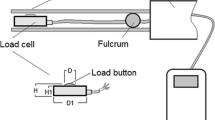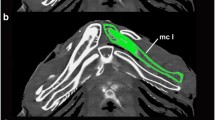Abstract
Bite damage patterns have long been used to estimate shark species and body size, with somewhat limited success. The lack of fit between damage patterns and shark size is partially due to variation in tooth size and shape within an individual. The ability to accurately predict body size from bite patterns is important for better understanding the ecological and behavioral underpinnings of shark bites/attacks on marine organisms, humans, and submarine equipment. To this end, we measured interdental distance (IDD) between the most labial teeth in the first six tooth files on both the upper and lower jaws, as well as the circumference of the portion of each jaw that bears teeth, for prepared jaw sets from fourteen shark species and regressed these data against total length. IDD is allometric as well as an accurate predictor of total length in all species examined, except Carcharhinus acronotus. Tooth-bearing circumference is also allometric and predictive of total length in all species. Though considerable overlap exists in IDD and circumference ranges among species for the total length ranges examined, Carcharodon carcharias and Isurus sp. can be differentiated from Carcharhinus limbatus, Carcharhinus brevipinna, and C. acronotus based on these values alone. When combined with knowledge of species-specific feeding behavior, geographic distribution, and habitat preferences, these simple measures from bite damage patterns allow quick, accurate assessment of shark size and potential species.





Similar content being viewed by others
References
Alcorn DJ, Kam AKH (1986) Fatal shark attack on a Hawaiian monk seal (Monachus schauinslandi). Mar Mammal Sci 2:313–315
Auerbach PS, Burgess GH (2007) Injuries from nonvenomous aquatic animals. In: Auerbach PS (ed) Wilderness medicine, 5th edn. Elsevier, New York, pp 1654–1691
Baldridge HD (1973) Shark attack against man: a program of data reduction and analysis. Office of naval research, Mote Marine Laboratory, Sarasota, FL, p 94
Berteaux HO, Prindle B (1987) Deep sea moorings fishbite handbook. Office of naval research, technical report WHOI-87-8. Woods Hole Oceanographic Institute, MA
Bishop JE, Butt RP, Laurent GJ (1993) The role of mechanical force in the regulation of fibroblast function: implications for enhanced collagen disposition during pulmonary vascular remodeling. Eur Respir Rev 3:613–617
Burgess GH (2008) International shark attack file. Florida Museum of Natural History. https://doi.org/www.flmnh.ufl.edu/fish/sharks/ISAF/ISAF.htm
Butt RP, Laurent GJ, Bishop JE (1995) Mechanical load and polypeptide growth factors stimulate cardiac fibroblast activity. Ann N Y Acad Sci 752:387–393
Byard RW, Gilbert JD, Brown K (2000) Pathologic features of fatal shark attacks. Am J Foren Med Path 21:225–229
Caldicott DGE, Mahajani R, Kuhn M (2001) The anatomy of a shark attack: a case report and review of the literature. Injury 32:445–453
Campana SE, Joyce WN (2004) Temperature and depth associations of porbeagle shark (Lamna nasus) in the northwest Atlantic. Fish Oceanogr 13:52–64
Compagno LJV (1984a) FAO species catalogue. Sharks of the world. An annotated and illustrated catalogue of shark species known to date. Part 1. Hexanchiformes to Lamniformes. FAO fisheries synopsis 125, vol 4
Compagno LJV (1984b) FAO species catalogue. Sharks of the world. an annotated and illustrated catalogue of shark species known to date. Part 2. Carcharhiniformes. FAO fisheries synopsis 125 Vol. 4
Cortes E (1999) Standardized diet compositions and trophic levels of sharks. ICES J Mar Sci 56:707–717
Davies DH, Campbell GD (1962) The aetiology, clinical pathology and treatment of shark attack. J Roy Nav Med Serv 3:110–136
Dudley SFJ, Simpfendorfer CA (2006) Population status of 14 shark species caught in the protective gillnets off KwaZulu-Natal beaches, South Africa, 1978–2003. Mar Freshwater Res 57:225–240
Gafner G, Smith ED, Retief EA (1985) Tooth x-ray as a cue to species of shark. S Afr J Sci 81:376–379
Gallo-Reynoso J-P, Figueroa-Carranza A-L (1992) A cookiecutter shark wound on a Guadalupe fur seal male. Mar Mammal Sci 8:428–430
Gasparini JL, Sazima I (1996) A stranded melon-headed whale, Peponocephala electra, in southeastern Brazil, with comments on wounds from the cookiecutter shark, Isistius brasiliensis. Mar Mammal Sci 12:308–312
George JC, Philo LM, Hazard K, Withrow D, Carroll GM, Suydam R (1994) Frequency of killer whale (Orcinus orca) attacks and ship collisions based on scarring on bowhead whales (Balaena mysticetus) of the Bering-Chukchi-Beaufort Seas stock. Arctic 47:247–255
Gibson QA (2006) Non-lethal shark attack on a bottlenose Dolphin (Tursiops Sp.) calf. Mar Mammal Sci 22:190–197
Graham JB, Dewar H, Lai NC, Lowell WR, Arce SM (1990) Aspects of shark swimming performance determined using a large water tunnel. J Exp Biol 151:175–192
Hazin FHV, Burgess GH, Carvalho FC (2008) A shark attack outbreak off Recife, Pernambuco, Brazil: 1992–2006. Bull Mar Sci 82:199–212
Heithaus MR (2001a) The biology of tiger sharks, Galeocerdo cuvier, in Shark Bay, western Australia: sex ratio, size distribution, diet, and seasonal changes in catch rates. Env Biol Fishes 61:25–36
Heithaus MR (2001b) Shark attacks on bottlenose dolphins (Tursiops aduncus) in Shark Bay, Western Australia: attack rate, bite scar frequencies, and attack seasonality. Mar Mammal Sci 17:526–539
Heithaus MR, Frid A, Dill LM (2002a) Shark-inflicted injury frequency, escape ability, and habitat use of green and loggerhead turtles. Mar Biol 140:229–236
Heithaus MR, Frid A, Dill LM (2002b) Species and sex-class differences in shark-inflicted injury frequencies, escape ability, and habitat use of green and loggerhead turtles. Mar Biol 40:229–236
Heithaus MR, Frid A, Wirsing AJ, Bejdar L, Dill LM (2005) Biology of sea turtles under risk from tiger sharks at a foraging ground. Mar Ecol-Prog Ser 288:285–294
Hoffmayer ER, Parsons GR (2003) Food habits of three shark species from the Mississippi Sound in the northern Gulf of Mexico. Southeast Nat 2:271–280
Hopkins TE, Cech JJ (2003) The influence of environmental variables on the distribution and abundance of three elasmobranchs in Tomales Bay, California. Env Biol Fishes 66:279–291
Huber DR, Weggelaar CL, Motta PJ (2006) Scaling of bite force in the blacktip shark, Carcharhinus limbatus. Zool 109:109–119
Johnson RH, Nelson DR (1973) Agonistic display in the gray reef shark, Carcharhinus menisorrah, and its relationship to attacks on man. Copeia: 76–84
Kirkwood R, Dickie J (2005) Mobbing of a great white shark (Carcharodon carcharias) by adult male Australian fur seals (Arctocephalus pusillus doriferus). Mar Mammal Sci 21:336–339
Klimley AP, Pyle P, Anderson SD (1996) The behavior of white sharks and their pinniped prey during predatory attacks. In: Klimley AP, Ainley DG (eds) Great white sharks: the biology of Carcharodon carcharias. Academic Press, New York, pp 175–192
Klimley AP, Le Boeuf BJ, Cautara KM, Richert JE, Davis SF, Van Sommeran S, Kelly JT (2001) The hunting strategy of white sharks (Carcharodon carcharias) near a seal colony. Mar Biol 138:617–636
Long DJ (1996) Records of white shark-bitten leatherback sea turtles along the Central California coast. In: Klimley AP, Ainley DG (eds) Great white sharks: the biology of Carcharodon carcharias. Academic Press, New York, pp 317–319
Long DJ, Jones RE (1996) White shark predation and scavenging on cetaceans in the eastern north Pacific Ocean. In: Klimley AP, Ainley DG (eds) Great white sharks: the biology of Carcharodon carcharias. Academic Press, New York, pp 293–307
Maldini D (2003) Evidence of predation by a tiger shark (Galeocerdo cuvier) on a spotted dolphin (Stenella attenuata) off O’ahu, Hawai’i. Aquat Mammals 29.1:84–87
Mann J, Barnett H (1999) Lethal tiger shark (Galeocerdo cuvier) attack on bottlenose dolphin (Tursiops sp.) calf: Defense and reactions by the mother. Mar Mammal Sci 15:568–575
Marra LJ (1989) Sharkbite on the SL submarine lightwave cable system: history, causes, and resolution. IEEE J Oceanic Eng 14:230–237
Martin RA, Hammerschlag N, Collier RS, Fallows C (2005) Predatory behaviour of white sharks (Carcharodon carcharias) at Seal Island, South Africa. J Mar Biol Assoc UK 85:1121–1135
Mays PK, McAnulty RJ, Campa JS, Laurent GJ (1991) Age-related changes in collagen synthesis and degradation in rat tissues. Biochem J 276:307–313
Miller DJ, Collier RS (1981) Shark attacks in California and Oregon 1926–1979. Calif Fish Game 67:76–104
Mutsaers SE, Bishop JE, McGrouther G, Laurent GJ (1997) Mechanisms of tissue repair: from wound healing to fibrosis. Int J Biochem Cell Biol 29:5–17
Pratt HL Jr (1979) Reproduction in the blue shark, Prionace glauca. Fish Bull 77:445–470
Pyle P, Anderson SD, Klimley AP, Henderson RP (1996) Environmental factors affecting the occurrence and behavior of white sharks at the Farallon Islands, California. In: Klimley AP, Ainley DG (eds) Great white sharks: the biology of Carcharodon carcharias. Academic Press, Inc., San Diego, pp 281–291
Ritter E, Levine M (2004) Use of forensic analysis to better understand shark attack behaviour. J Forensic Odontostomatol 22:40–46
Ritter EK, Levine M (2005) Bite motivation of sharks reflected by the wound structure on humans. Am J Forensic Med Path 26(2):136–140
Shimada K (2002) The relationship between the tooth size and total body length in the white shark, Carcharodon carcharias (Lamniformes: Lamnidae). J Fossil Res 35:28–33
Shimada K (2004) The relationship between the tooth size and total body length in the sandtiger shark, Carcharias taurus (Lamniformes: Odontaspidae). J Fossil Res 37:76–81
Shimada K, Seigel JA (2005) The relationship between the tooth size and total body length in the goblin shark, Mitsukurina owstoni (Lamnidae: Mitsukurinidae). J Fossil Res 38:49–56
Snelson FF, Mullligan TJ, Williams SE (1984) Food habits, occurrence, and population structure of the bull shark, Carcharhinus leucas, in Florida coastal lagoons. Bull Mar Sci 34:71–80
Snodgrass JM, Gilbert PW (1967) A shark-bite meter. In: Gilbert PW, Mathewson RF, Rall DP (eds) Sharks, Skates, and Rays. Johns Hopkins Press, Baltimore, pp 331–337
Stillwell CE, Kohler NE (1982) Food, feeding habits, and estimates of daily ration of the shortfin mako (Isurus oxyrinchus) in the northwest Atlantic. Can J Fish Aquatic Sci 39:407–414
Tricas TC (1985) Feeding ethology of the white shark, Carcharodon carcharias. Mem South Calif Acad Sci 9:81–91
van den Hoff J, Morrice MG (2008) Sleeper shark (Somniosus antarcticus) and other bite wounds observed on southern elephant seals (Mirounga leonina) at Macquarie Island. Mar Mammal Sci 24:239–247
Wintner SP, Dudley SFJ, Kistnasamy N, Everett B (2002) Age and growth estimates for the Zambezi shark, Cacharhinus leucas, from the east coast of South Africa. Mar Freshw Res 53:557–566
Woolgar JD, Cliff G, Nair R, Hafez H, Robbs JV (2001) Shark attack: review of 86 consecutive cases. Inj Infec Crit Care 50:887–891
Wu EH (1994) Kinematic analysis of jaw protrusion in orectolobiform sharks: a new mechanism for jaw protrusion in elasmobranchs. J Morphol 222:175–190
Zahuranec BJ (2003) Marine attacks on towed acoustic arrays. Lead Edge 22:371–372
Zar JH (1999) Biostatistical analysis. Prentice Hall, Upper Saddle River
Acknowledgments
The authors are indebted to G. Hubbell, E. Clarke, J. Castro, and R. Hueter for access to their scientific collections of shark jaws, without which this project would not have been possible. Our sincere thanks to H. Hughes for assisting with preliminary data collection. Two anonymous reviewers contributed substantially to the final format of the manuscript. Funding for this project was provided in part by CAPES fellowship (BEX 1277-02/2) to A.L.F.C. The photograph in Fig. 5 was contributed by R. Honebrink. All procedures described herein comply with current laws of the United States of America.
Author information
Authors and Affiliations
Corresponding author
Additional information
Communicated by U. Sommer.
Electronic supplementary material
Rights and permissions
About this article
Cite this article
Lowry, D., de Castro, A.L.F., Mara, K. et al. Determining shark size from forensic analysis of bite damage. Mar Biol 156, 2483–2492 (2009). https://doi.org/10.1007/s00227-009-1273-3
Received:
Accepted:
Published:
Issue Date:
DOI: https://doi.org/10.1007/s00227-009-1273-3




